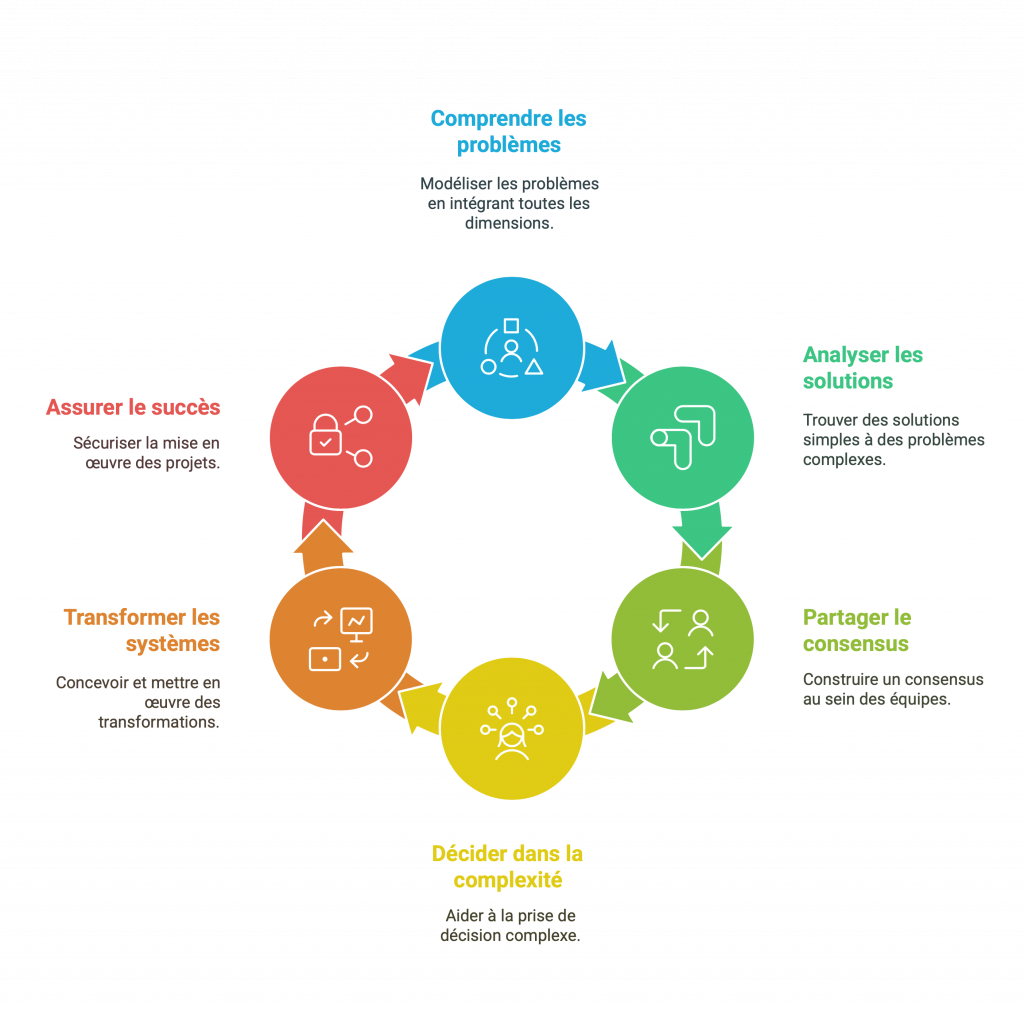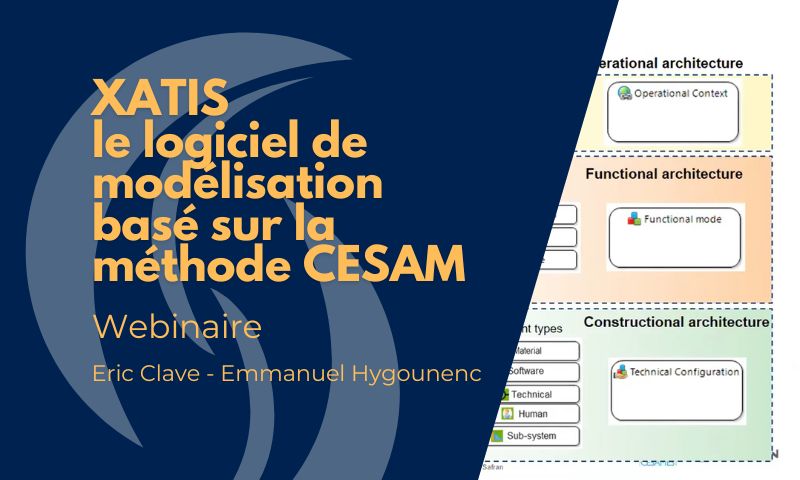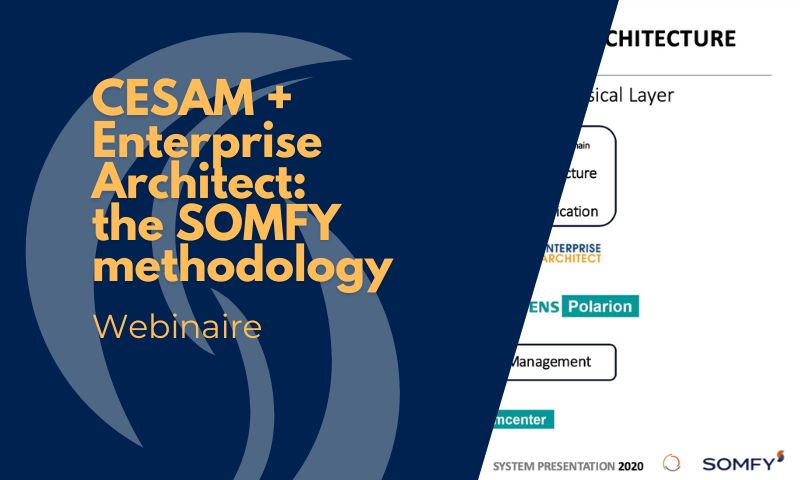Systems Architecture
A STRATEGIC ADVANTAGE FOR MANUFACTURERS
Optimizing the development of complex projects
System architecture is the discipline that synthesizes the methods and tools allowing an exhaustive and coherent modeling of a complex system in three dimensions: operational, functional and organic, in order to manage it efficiently throughout its life cycle (design, testing, deployment, maintenance, etc.)
| System architecture: a strategic competitive advantage
System architecture is a systemic approach and an international standard for engineering methodologies, providing an explicit and holistic representation of a complex system.
A product, organization, or information system is considered “complex” when it is characterized by the presence of numerous stakeholders, technologies, interconnected components, and numerous interfaces to cover.
This creates integration difficulties during the design, development, and production (manufacturing, operation) phases: siloed operations by the various stakeholders, local trade-offs made at the expense of global optima, and sequential activities resulting in delays.
Adopting an architectural approach when developing complex systems allows for the design of the appropriate solution. This approach offers rational and collaborative methods that promote optimal and shared decisions while ensuring security and reducing costs and delivery times.

| The CESAMES approach: immediate added value
Improve operational efficiency
System architecture helps reduce costs while growing the business by being frugal in the design, development and maintenance phases and it optimizes the investment/benefit ratio by relying on the “just enough” systemic approach.
Guarantee coverage of needs
System architecture allows parts of a product to be modified at any time while avoiding the domino effect and generates differentiating and competitive solutions by balancing the points of view and risks of stakeholders in the tender phase.
Upskill the project team
CESAMES strengthens the team’s skills by developing systems architecture skills internally and empowers team members so that they can develop their own perspectives and be autonomous.
Notre approche intégrée d’architecture de systèmes s’appuie sur le cadre d’architecture de systèmes CESAM basé sur des modèles et un mode de travail collaboratif.
| Our approach is based on the CESAM architectural framework
An architectural approach based on the CESAM framework aims to control the complexity of the system of interest and reduce project risks by anticipating design issues. To achieve this, it ensures consistency between different perspectives on the system and the completeness of the analysis through the following dimensions:
— Operational: interactions with stakeholders.
— Functional: functions the system must perform.
— Constructional: technical components that implement these functions.
Operational Vision
What must the system accomplish for its stakeholders?
(External perspective “black box”)
➤ Objective
Understand the interactions between the system and its environment.
➤ Content
— Identification of stakeholders (users, maintainers, authorities, etc.).
— Analysis of needs expressed in the form of use cases or business objectives.
— Definition of operational scenarios illustrating how the system interacts in different contexts.
— Construction of environment diagrams, lifecycle diagrams, and operational flows.
➤ Role
Capture the expected value of the system by all stakeholders.
Functional Vision
What must the system do to accomplish its mission?
(Grey box perspective)
➤ Objective
Define the abstract internal behavior of the system, without mentioning technical solutions.
➤ Content
— Decomposition of the system into technology-independent functions.
— Identification of functional modes (normal, degraded, standby, etc.).
— Representation of information, energy, or material flows between functions.
— Development of functional scenarios derived from operational scenarios.
➤ Role
Translate operational needs into elementary functions to be satisfied.
Constructional Vision
How is the system physically or logically realized?
(Internal “white box” perspective)
➤ Objective
Define the technical solution (physical, software, or organizational architecture) that implements the functions.
➤ Content
— Definition of components (hardware, software, and human modules).
— Identification of interfaces and connections between components.
— Definition of system configurations, technical constraints, and design choices.
— Allocation of functions to components.
➤ Role
Design an optimal technical architecture, balancing functional requirements, technological constraints, and costs.
||||| Ressources

Webinaire [FR]
XATIS, le logiciel de modélisation basé sur la méthode CESAM
Safran Engineering Services commercialise « XATIS », un logiciel permettant d’optimiser la conception de systèmes complexes.
Ce logiciel, conçu pour aider les architectes systèmes à réduire les cycles de développement des produits, s’appuie sur CESAM, notre cadre d’Architecture et de Modélisation Système, utilisé par 8000 professionnels formés ou certifiés.
XATIS est un outil de modélisation de systèmes intégrés complexes, depuis la phase de recueil des besoins jusqu’à la conception préliminaire, en passant par l’étape de spécification. Il permet d’élaborer différentes architectures, de les comparer et de choisir la meilleure, en prenant en compte les contraintes d’industrialisation, d’exploitation, de maintenance et de retrait de service du système. « XATIS est un outil conçu par des architectes pour des architectes ! »
Dans ce webinaire, Eric Clavé, responsable du projet XATIS chez SAFRAN, présente les grandes lignes du projet puis Emmanuel Hygounenc, architecte système certifié CESAM, partage les grandes fonctionnalités du logiciel ainsi que les différentes vues d’architecture

Webinaire [FR]
Comment implémenter la méthode CESAM dans Capella ?
Dans ce webinaire, nous nous concentrons sur l’implémentation du cadre CESAM dans Capella.
CESAM est un cadre d’Architecture et de Modélisation Système disponible depuis 2011 et dorénavant utilisé par 10 000 professionnels formés ou certifiés. Il est entièrement compatible avec tous les cadres MBSE (Arcadia, INCOSE, NASA) et les outils (Capella, Cameo, Entreprise Architect, Rhapsody, XATIS) du marché.
Il a fait ses preuves dans de nombreux contextes industriels et services, en apportant des résultats concrets et significatifs pour les projets. De par son positionnement agnostique vis-à-vis des outils de modélisation, il est parfaitement implémentable dans les différents outils de modélisation, dont Capella.

Webinar [EN]
CESAM + Enterprise Architect: the SOMFY methodology
While implementing a product line approach, the challenge that faced SOMFY engineering team was the appropriate choice of the tooled method to be used. This choice was guided by corporate considerations, instantiation to the specific issues and needs of the SOMFY product line approach and of course, by the maturity of the available tools.
Based upon their previous operational experience acquired in a large company and a decision-making process defining the key success factors, the systems engineering team decided to develop the SomfY System Tools Methodology (SYSTM): approach based upon CESAMES Systems Architecting Method combined with the Enterprise Architect tool.
During this webinar, Thibaut Desbrugeres and Stephane Bigonneau, both Sytems Architects at SOMFY share:
— the key success factors of their project in a mid-cap company,
— the benefits of their ready-made tooled method approach,
— a demo of the customized Enterprise Architect tool.
